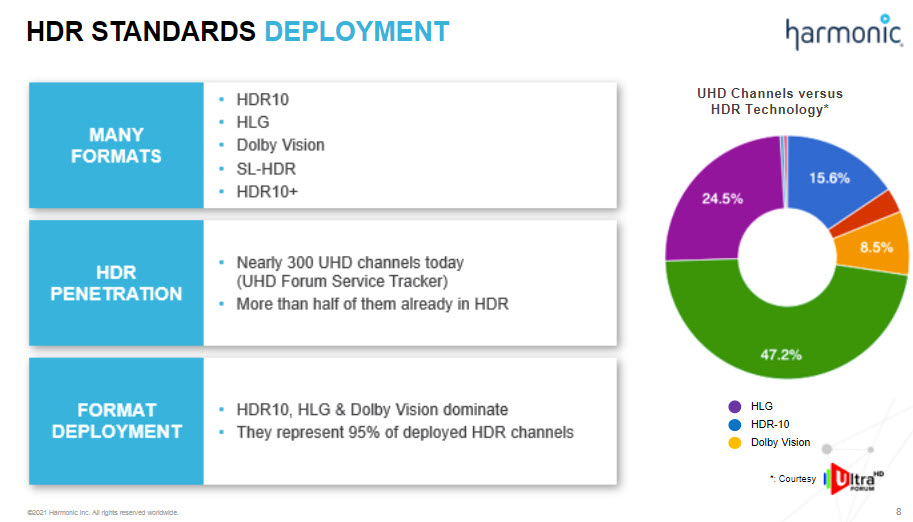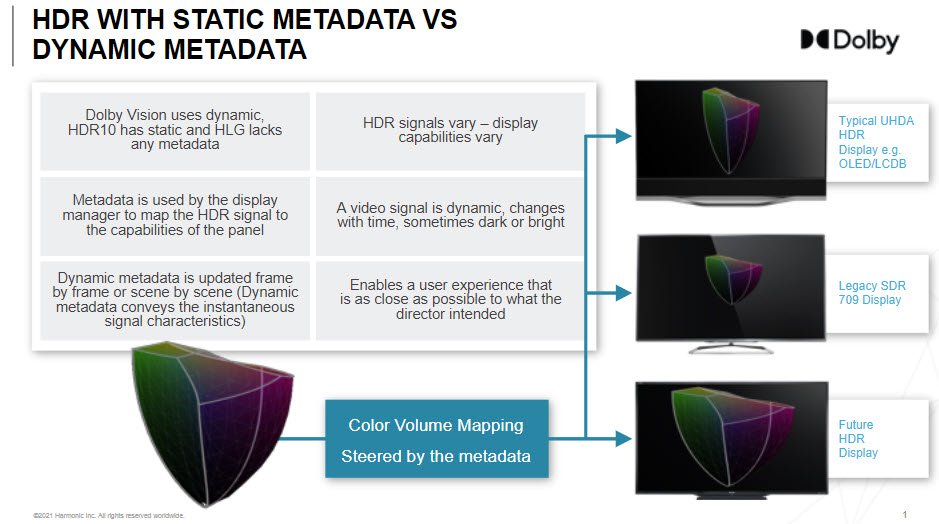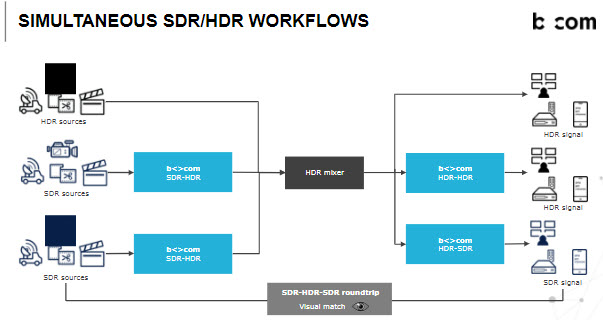Harmonic Inc, the provider of video technology for broadcasters and streamers has been holding a series of webinars in a ‘Live Summit’ event. We sat in on an interesting panel session today on the topic of “Advanced Techniques to Optimize HDR Production and Delivery”. We’re not sure we heard a lot of advanced techniques, but there was some useful information on HDR adoption.

The panelists were:
- Felix Nemirovsky (FN) – Media Delivery Ecosystem Expert – Dolby Labs
- Tania Pouli (TP) – Deputy Lab Manager – Advanced Media Content at IRT b<>com
- Stephane Cloirec (SC) – Vice President, Video Appliance Product Management at Harmonic
- Prinyar Boon (PB)- Product Manager at Phabrix
The session was moderated by Stuart Thomson (ST), Editor of Digital TV Europe and was structured around a Q&A format, so we’ll cover the event like that.
ST: What is HDR?
SC: Today’s systems are only capturing a tiny part of the range of what the eye can see. The eye can see much more in the dark and bright areas of the image than can be shown in SDR. HDR (for luminance) goes alongside wide colour gamut (WCG) for colour.
TP: There are advantages to HDR in the creation process. With SDR every device or part of the chain is limited. With HDR you can capture scenes that were too challenging before. You can use light to create differently because of the range that is available.
FN: In the days of SDR – video content was only shown on SDR TVs. Now, not only TVs are being used to watch and other devices such as consoles or other systems have more range and that can be exploited.
ST To what extent does it matter that there are different standards?
SC: Standards are essential for economies of scale and interoperability. Initially with HDR there were just a few available but there are more now. The UltraHD Forum has been tracking the deployments of HDR in UltraHD channels. More than 50% of the nearly 300 UHD channels now being broadcaster are in HDR with HLG and HDR10 as the main technologies (see the interesting chart below – ed)
FN: There are major differences between the technologies. HLG has no metadata, HDR10 has metadata, but it’s static, DV has dynamic metadata. Even static is better than none at all. It’s all about delivering “the director’s intent”. Dynamic metadata describes a lot of different things and is not just a single data point. You can use the dynamic data to adjust the look differently for each type of TV (e.g. HDR and SDR) and it can be adjusted frame by frame or scene by scene. With metadata, there can be a single stream that will still deliver a good and known image for each type of set.
ST: What are the challenges to accommodate HDR?
FN: Production doesn’t create or capture metadata. Cameras are expensive and slow to change and so adding metadata will take time. There are a lot of sources of content to cover. Content can come into production suites as PQ or HLG and then goes onward to the encoder. At that point the broadcaster can decide how to distribute depending on the audience and the broadcast technology. Metadata can be added dynamically to content.
SC: Looking at production, you can’t capture the content in a particular way as you may not know how it will be distributed. That kind of decision has to be made at the ingest to minimise format conversions and rendering as required at the output. Phabrix uses b<>Com technology to perform conversion between different formats.
TP: There are different formats, but also different approaches. There are two main ones on production – a conservative on based on BT2408 – that is to say similar to SDR but extended. That can be a useful approach if you don’t know what the content will be e.g. with variable brightness and graphics. The alternative is to focus mainly about HDR and then map down to SDR. These approaches need different profiles and methods, but can be supported on the same content.
PB: Workflows to do this are now established. For sports, e.g., you may need 3 stops of difference to work with in content brightness so you have to be able to deal with that. Graphics can also be a challenge for downmapping to SDR. You need to ensure the chain is properly calibrated. Using PQ does allow you to use consumer TVs for checking as they all support BQ now, but watching cameras with different S-Log profiles may need different approaches. 10 bit colour/brightness needs to be supported. Premier League matches are being done this way on a very regular basis already.
ST – Is SDR only for HD while HDR is only for UltraHD?
SC: You should decouple the marketing from the technology. Putting HDR along with UHD makes a more compelling package for operators that are trying to persuade consumers to upgrade to UHD services. However, the real change in user experience is from the change from SDR to HDR even with HD content. There are moves in some parts of the world to adopt HDR with HD signals. For example, there are more tests of FHD with HDR in ATSC 3 tests and trials in the US. That gives a better experience without the extra bandwidth of UltraHD.
FN: This is a question for broadcasters, it’s not a streaming issue for VOD which can support UltraHD. It’s not just marketing. However, when you have an established channel that has been operating for several years, producers are reluctant to add costs such as switching to HDR. For example, most HDR production may need more cost and time.
PB – Replays and slow motion tend to be shown in 1080P even in UHD productions – but they still look very good.
ST – Can I Implement HDR for live streaming and file-based VOD?
SC: There are no technical difficulties now to perform live transformations for different formats. It can be done seamlessly using the latest equipment.
FN: In the VOD world, creatives understood the reason to provide good and known quality content – and they can do it as there are fewer complications than in live broadcast. This is creating competition between the VOD and live experience. If consumers get used to HDR in VOD content they will want to see it in live content, too. Even HLG content can be mapped to DV.
ST – What Hinders HDR adoption?
TP: If the consumer gets used to HDR content via VOD and cannot get it other ways, they will be disappointed. If good HDR content is not made available, the consumers may also think ‘HDR doesn’t work’ if the content isn’t there when they have a new TV. Dark SDR may lead to disappointment, if the content is not correctly adjusted.
ST – Can HDR be affordable if you are also having to deliver SDR? Especially live.
TP: The quick and easy response (the session was accelerating at that point) is that there are easy conversions available.
FN: The only really efficient way is not to do multiple production/delivery. Best to pick one. Biggest cost is two separate channels so you really have to work out how to use a single stream for any device.
ST – What are the drivers for HDR Production and Distribution.
SC: Live production in HDR is being developed especially for major events such as the Euros soccer and the Olympics. HDR is no longer a question about VOD – it’s really an issue for live only.
ST – How will HDR adoption look in a year’s time.
FN: This is not an if, but a when for broadcasters although it needs the right sets to be in homes.
TP: There should be a big boost from live sports after the pandemic
PB: The pandemic has caused a pause. Many hours of HDR coverage of the Olympics was promised, but hasn’t arrived yet.
SC: Looking at the numbers, even 3 months ago the number of channels with HDR was ‘way below 50%’ so broadcasters are moving in the right direction.
(BR)





